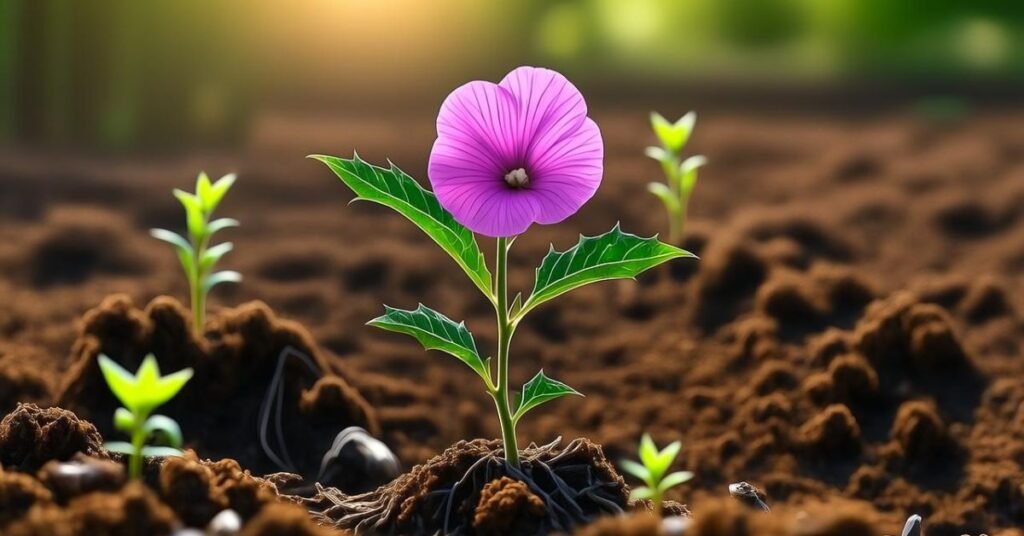Introduction
A plant with purple flower is any plant that produces blossoms in shades of violet, lavender, or deep purple. These plants add elegance and charm to gardens. They can be small ground covers or tall, striking blooms. Their rich colors stand out beautifully against green foliage. Purple flowers often symbolize grace, creativity, and peace.
Imagine walking into a garden filled with soft lavender waves or deep purple blooms glowing under the sun. These plants can transform a dull space into a vibrant and inviting paradise. Their colors attract the eye and create a sense of calm. Many gardeners use them as focal points to make their landscape unforgettable.
From fragrant lavender to hardy salvia, there is a wide variety of purple flowering plants to suit different climates. Some bloom in spring, while others last until fall. Whether planted in borders, pots, or garden beds, they bring beauty all season long.
History of Purple Flowers
Purple flowers have a long and rich history. In ancient times, purple was a rare and royal color. It was linked to kings, queens, and luxury. The dye for purple was expensive and hard to make. This made purple flowers a symbol of wealth and power. Many cultures saw them as signs of wisdom and dignity.
Over the centuries, purple flowers also gained spiritual meaning. In some traditions, they represented peace and imagination. Artists often painted them to show beauty and mystery. Today, they are still loved for their elegance. Their history makes them more than just pretty blooms; they carry stories from the past.
Produce Purple Flower
Producing purple flowers starts with choosing the right plant variety. Some plants naturally grow purple blooms, while others are bred for color. Soil quality, sunlight, and proper watering are key for healthy growth. The right nutrients help the flowers develop rich and vibrant shades.

Regular care is important for steady blooming. Pruning old flowers encourages new ones to grow. Consistent watering keeps the plant strong. Protecting it from pests and diseases ensures better results. With the right conditions, producing purple flowers becomes easy and rewarding.
Adaptations
Purple flowers have special features that help them survive. They use color, scent, and shape to attract pollinators. These adaptations make them thrive in different environments.
- Bright purple petals attract bees and butterflies.
- Strong fragrance helps pollinators find them.
- Some have deep nectar tubes for certain insects.
- Thick petals protect against harsh sunlight.
- Seasonal blooming matches pollinator activity.
Soil Type
Purple flowers grow best in well drained soil. Rich, fertile soil supports healthy roots. Loamy soil is ideal for most varieties. Some prefer slightly acidic conditions for brighter blooms. Adding compost improves soil texture and nutrients. Good soil helps the plant produce vibrant purple flowers all season.
Sunlight Requirements
Most purple flowers need full sun to thrive. They grow best with at least six hours of direct sunlight daily. Sunlight helps them produce vibrant colors and healthy blooms. Some varieties can tolerate partial shade. Too little light can cause weak stems and fewer flowers. Proper sunlight keeps the plant strong and beautiful.
Types of Purple Flowers
Purple flowers come in many shapes and sizes. Some are small and delicate, while others are bold and dramatic. Lavender, lilac, and iris are popular choices for gardens. Salvia and petunia add bright splashes of purple to any space. Each type has its own charm and growing needs.

These flowers can be used in gardens, pots, or bouquets. Some bloom in spring, while others last until late autumn. Choosing different types ensures color throughout the year. Here is a table of common purple flowers and their blooming seasons:
| Flower Name | Blooming Season | Special Feature |
| Lavender | Summer | Fragrant blooms |
| Lilac | Spring | Sweet scent |
| Iris | Spring Summer | Large petals |
| Salvia | Summer Fall | Attracts bees |
| Petunia | Spring Fall | Long blooming |
Tulips
Tulips are bright and elegant flowers. They come in many colors, including beautiful shades of purple. These flowers grow from bulbs and bloom in spring. They prefer cool weather and well drained soil. Tulips are often used in gardens, pots, and floral arrangements. Their simple yet graceful shape makes them a favorite for decoration and gifts.
Lavender
Lavender is a fragrant and beautiful plant. It produces soft purple flowers that bloom in summer. This plant loves full sun and well drained soil. Lavender is often grown for its calming scent and essential oils. It attracts bees and butterflies to the garden. Its blooms are also used in dried arrangements and herbal crafts.
Allium

A purple flower cluster adorns the leaves of Allium, a striking plant. During the late spring and early summer, it blooms. The tall stems make it stand out in any garden. The best soil for allium is one that is well drained and gets full sun. It is easy to grow and resistant to most pests. These flowers add height, color, and texture to landscapes.
Purple Dragon Lamium
Purple Dragon Lamium is a low growing plant with bright purple flowers. It blooms from late spring to early summer. The plant has silver green leaves that add extra beauty. It grows well in partial shade and moist, well drained soil. There is a lot of use for Purple Dragon Lamium as a ground cover. In addition to its hardiness and ease of maintenance, it attracts pollinators as well.
Purple Plants
Purple plants are known for their rich and vibrant colors. They can have purple flowers, leaves, or both. These plants add depth and contrast to gardens. Some are ornamental, while others are grown for their fragrance or herbal use. Their unique color makes them stand out in any landscape.
Many purple plants are easy to grow and care for. Well drained soil and sunny spots are ideal for growing them. Some attract pollinators like bees and butterflies. Popular examples include lavender, coleus, and purple basil. With the right care, they bring beauty to gardens all year round.
Seasons
Purple flowers can bloom in different seasons. Colorful and fresh, they appear in spring. Others shine in summer with bright and bold shades. Autumn brings deeper tones, while winter varieties are rare but striking. Planting different seasonal types keeps the garden colorful all year.
Here are examples of purple flowers by season:
- Spring :Lilac, Iris, Wisteria
- Summer :Lavender, Salvia, Petunia
- Autumn :Aster, Chrysanthemum, Verbena
- Winter : Hellebore, Viola, Cyclamen
Plant and Care
Planting purple flowers is simple with the right steps. Choose healthy seeds or young plants. Pick a spot with enough sunlight or partial shade. Prepare the soil by adding compost for better growth. Space the plants well for airflow. Water them right after planting.
- Water regularly, but avoid overwatering.
- Remove faded flowers to promote new blooms.
- Fertilize during the growing season.
- Keep the area free from weeds.
- Protect plants from pests and harsh weather.
Beauty of Purple Flower
The beauty of purple flowers lies in their rich and calming shades. They add elegance and charm to any space. A soft lavender to a deep violet can be found among their colors.

Purple flowers stand out in gardens and bouquets. They symbolize grace, creativity, and peace. Their presence can brighten moods and create a soothing atmosphere.
Conclusion
Purple flowers bring beauty and elegance to any garden. They come in many varieties and bloom in different seasons. With proper planting and care, they grow healthy and vibrant. Their colors attract pollinators and create a peaceful atmosphere. Adding purple flowers is a simple way to make any space more colorful and inviting.
FAQs
1. What do purple flowers symbolize?
Purple flowers often symbolize grace, creativity, and peace.
2. Which season is best for growing purple flowers?
Spring and summer are the most common seasons, but some varieties bloom in autumn or winter.
3. Are purple flowers easy to grow?
Yes, many purple flowers are low maintenance and grow well with basic care.
4. Can purple flowers grow indoors?
Yes, some varieties like lavender and violets can thrive indoors with enough light.
5. Do purple flowers attract pollinators?
Yes, pollinators, including bees, butterflies, and beetles, are attracted to their bright colors and scent.


